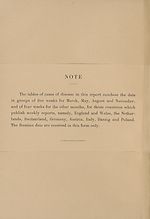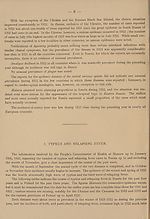Download files
Complete book:
Individual page:
Thumbnail gallery: Grid view | List view

LEAGUE OF NATIONS
NOTES ON THE EPIDEMIOLOGY OF 1922.
In Central and Eastern Europe, the outstanding feature of the epidemiological situation in
1922 as compared with the previous year was the extremely high prevalence of typhus and relapsing
fever in Russia, an increase of cholera in the Ukraine and a serious increase in the prevalence of ma¬
laria in Russia, especially of the tropical type. Russia remained the centre of devastating epidemics
which were even more severe in 1922 than in 1921. In Poland the typhus situation, while far less
serious than in Russia, showed no marked improvement in 1922, and the incidence of relapsing fever
increased. In most of the other countries the reports showed a decrease of these diseases.
It is too early at this date (February 15th, 1923) to make any forecast for 1923. There are many
unknown factors, and the statistical reports are so incomplete for recent months that it would not
be of much value. For Eastern Europe, at any rate, it would be rash to predict a return to anything
like the normal prevalence of the diseases which have appeared in epidemic form with more or less
regularity for the past few years.
SUMMARY.
This report deals in some detail with the situation of the most important epidemic diseases in
Eastern and Central Europe, namely : typhus and relapsing fever, asiatic cholera, dysentery, small¬
pox, plague, epidemic diseases of the central nervous system, malaria and enteric fever. It should
be remembered that the statements here made are based on the number of cases notified. While actual
comparisons between countries are generally impossible, the reports indicate roughly the chrono¬
logical movement of the diseases within comparable areas.
Rriefly summarised, the comparison between 1921 and 1922, in so far as the reports have been
received, is as follows :
The incidence of typhus and relapsing fever was fully twice as great in 1922 as in 1921 in Russia,
another extremely high epidemic wave having occurred in 1921-1922. This wave was quite double
i he 1920-1921 wave but was less than half as great as the second wave of 1919-1920, judging from
the number of cases reported. In Poland no improvement in 1922 over 1921 was noted for typhus,
and the prevalence of relapsing fever has greatly increased. In Lithuania, typhus increased and relap¬
sing fever showed no considerable change. In Latvia there was apparently an increase of typhus
but a decrease of relapsing fever. In other countries decreases are shown, but the total number of cases
reported are relatively small.
NOTES ON THE EPIDEMIOLOGY OF 1922.
In Central and Eastern Europe, the outstanding feature of the epidemiological situation in
1922 as compared with the previous year was the extremely high prevalence of typhus and relapsing
fever in Russia, an increase of cholera in the Ukraine and a serious increase in the prevalence of ma¬
laria in Russia, especially of the tropical type. Russia remained the centre of devastating epidemics
which were even more severe in 1922 than in 1921. In Poland the typhus situation, while far less
serious than in Russia, showed no marked improvement in 1922, and the incidence of relapsing fever
increased. In most of the other countries the reports showed a decrease of these diseases.
It is too early at this date (February 15th, 1923) to make any forecast for 1923. There are many
unknown factors, and the statistical reports are so incomplete for recent months that it would not
be of much value. For Eastern Europe, at any rate, it would be rash to predict a return to anything
like the normal prevalence of the diseases which have appeared in epidemic form with more or less
regularity for the past few years.
SUMMARY.
This report deals in some detail with the situation of the most important epidemic diseases in
Eastern and Central Europe, namely : typhus and relapsing fever, asiatic cholera, dysentery, small¬
pox, plague, epidemic diseases of the central nervous system, malaria and enteric fever. It should
be remembered that the statements here made are based on the number of cases notified. While actual
comparisons between countries are generally impossible, the reports indicate roughly the chrono¬
logical movement of the diseases within comparable areas.
Rriefly summarised, the comparison between 1921 and 1922, in so far as the reports have been
received, is as follows :
The incidence of typhus and relapsing fever was fully twice as great in 1922 as in 1921 in Russia,
another extremely high epidemic wave having occurred in 1921-1922. This wave was quite double
i he 1920-1921 wave but was less than half as great as the second wave of 1919-1920, judging from
the number of cases reported. In Poland no improvement in 1922 over 1921 was noted for typhus,
and the prevalence of relapsing fever has greatly increased. In Lithuania, typhus increased and relap¬
sing fever showed no considerable change. In Latvia there was apparently an increase of typhus
but a decrease of relapsing fever. In other countries decreases are shown, but the total number of cases
reported are relatively small.
Set display mode to:
![]() Universal Viewer |
Universal Viewer | ![]() Mirador |
Large image | Transcription
Mirador |
Large image | Transcription
Images and transcriptions on this page, including medium image downloads, may be used under the Creative Commons Attribution 4.0 International Licence unless otherwise stated. ![]()
| League of Nations > Health > Epidemic diseases in Eastern and Central Europe > (9) |
|---|
| Permanent URL | https://digital.nls.uk/190645966 |
|---|
| Shelfmark | LN.III |
|---|---|
| Description | Over 1,200 documents from the non-political organs of the League of Nations that dealt with health, disarmament, economic and financial matters for the duration of the League (1919-1945). Also online are statistical bulletins, essential facts, and an overview of the League by the first Secretary General, Sir Eric Drummond. These items are part of the Official Publications collection at the National Library of Scotland. |
|---|---|
| Additional NLS resources: |
|

